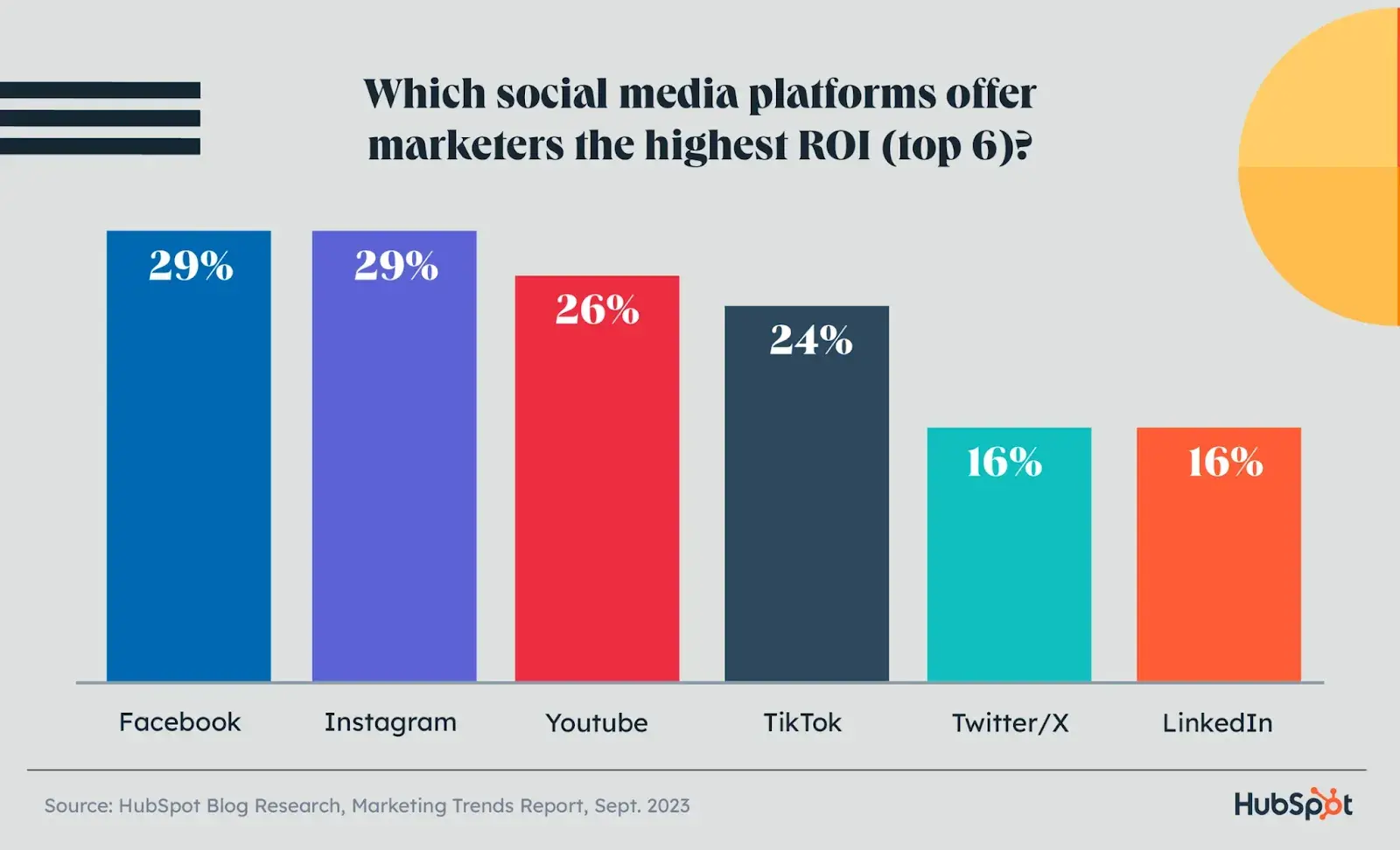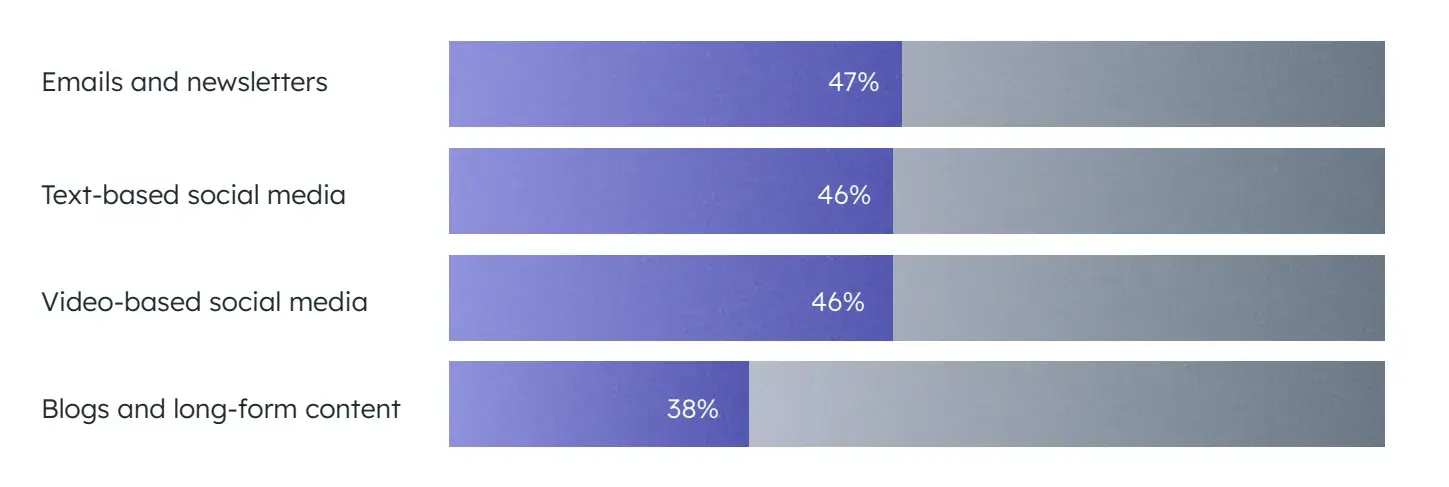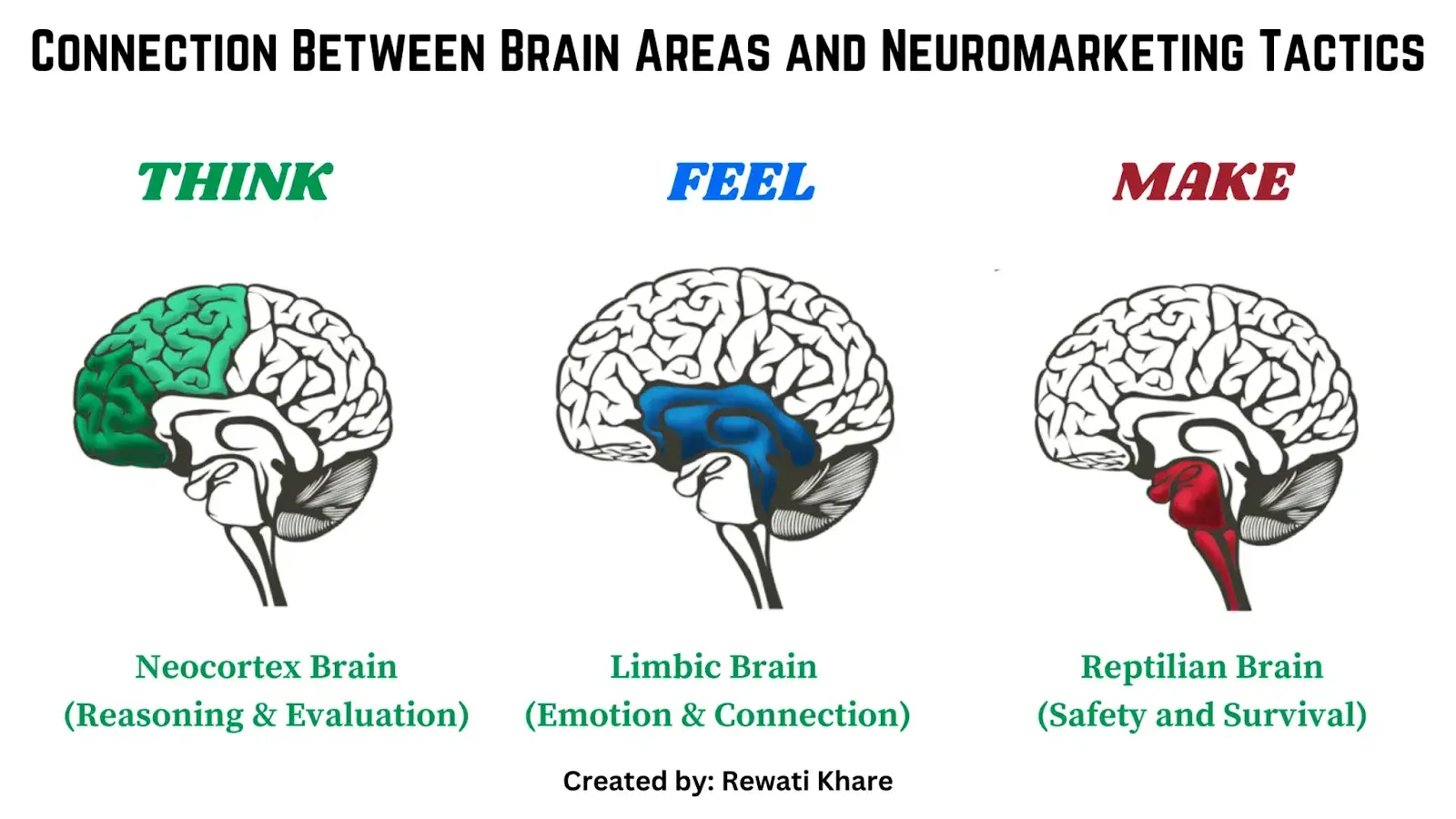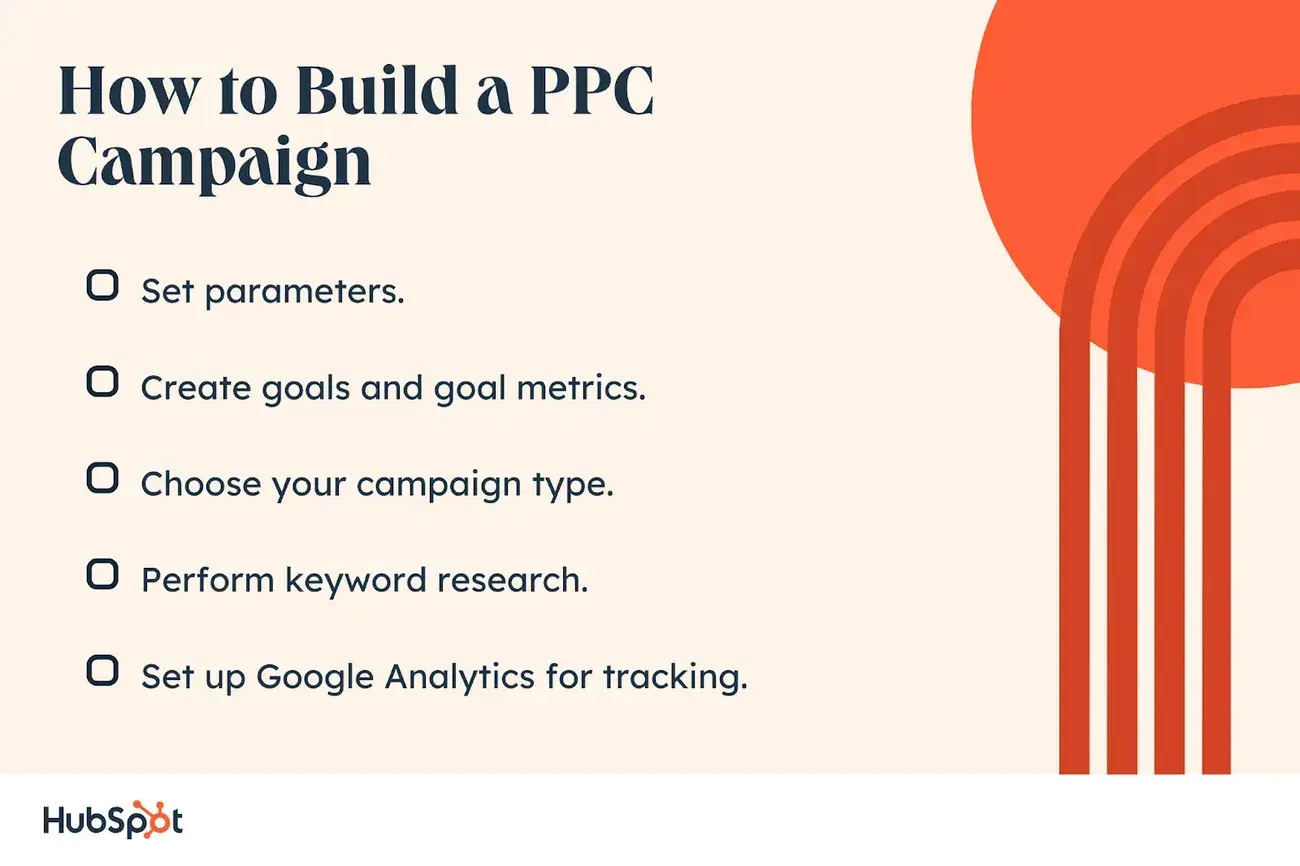
If you’d asked me early in my career to define what marketing is, I would have no doubts. “Marketing is about promoting products,” I’d say. But today, it’s one of the toughest questions to answer.

The term is so broad and flexible that it’s hard to pin down.
Marketing is present in all stages of the business, beginning to end. Without marketing, you can’t truly understand your audience, create a product that fits their needs, or successfully bring it to market.
Marketers have the firmest finger on the pulse of your consumer persona.
In this guide, I’ll show you in practice what marketing is, its different types, the 4 P’s, and how it differs from advertising.
Plus, I’ll spice things up with some expert tips. Whether you’re a pro looking for a refresher or a newbie trying to get the hang of things, I’ve got you covered.
Table of Contents
What is Marketing?
Marketing refers to any actions a company takes to attract an audience to the company’s product or services through high-quality messaging. Marketing aims to deliver standalone value for prospects and consumers through content, with the long-term goal of demonstrating product value, strengthening brand loyalty, and ultimately increasing sales.
What is the purpose of marketing?
Marketing is the process of getting people interested in your company’s product or service. This happens through market research, analysis, and understanding your ideal customer’s interests. Marketing pertains to all aspects of a business, including product development, distribution methods, sales, and advertising.
Modern marketing began in the 1950s when people started to use more than just print media to endorse a product. As TV — and soon, the internet — entered households, marketers could conduct entire campaigns across multiple platforms.
And as you might expect, over the last 70 years, marketers have become increasingly important in fine-tuning how a business sells a product to consumers to optimize success.
In fact, the fundamental purpose of marketing is to attract consumers to your brand through messaging. Ideally, that messaging will be helpful and educational to your target audience so you can convert consumers into leads.
Today, there are literally dozens of places to carry out a marketing campaign — where does one even start?
3 Pillar Types of Marketing
Where your marketing campaigns live depends entirely on where your customers spend their time. It’s up to you to conduct market research that determines which types of marketing — and which mix of tools within each type — is best for building your brand.
We have two main categories of marketing: digital and traditional. The third one, which isn’t so popular but extremely effective, also deserves a standalone place: neuromarketing. Let’s find out what comes with each.
1. Digital Marketing
Digital marketing is the use of online channels and platforms, like social media, email, and search engines, to promote and sell products or services.
The main parts of it are:
Search Engine Optimization
Abbreviated as “SEO,” this is the process of optimizing content on a website so that it appears in search engine results.
It‘s used by marketers to attract people who perform searches that imply they’re interested in learning about a particular industry.
29% of marketers consider SEO one of the leading trends they use. And just like in other areas, AI has made significant strides here too, greatly aiding in SEO.
Actually, 54% of marketers use AI tools for automating SEO tasks such as meta tags, link descriptions, and alt text.
Also, 45% of marketers believe AI/automation tools are best for optimizing websites, 40% say they improve the user experience, and 37% value them for saving time.
Blog Marketing
Blogs are no longer exclusive to the individual writer. Brands now publish blogs to write about their industry and nurture the interest of potential customers who browse the internet for information.
Today, most marketers use AI to assist with content creation. Nearly half (46%) rely on it for writing marketing copy, and over 40% use it to create outlines.
Personally, I love using it for proofreading — a time-saver for writers.

Social Media Marketing
Businesses can use Facebook, Instagram, Twitter, LinkedIn, and similar social networks to create impressions on their audience over time.

Social media is the top place where Gen Z and Millennials discover products, with 31% of people using it to find answers.
Additionally, 17% of users buy products on social media, and most sellers find it effective, with 59% seeing more sales in 2023 than in 2022.
It’s clear that investing time and energy in social media is worth it, and one of the best ways to speed things up is by, you guessed it — incorporating AI. In fact, 46% of marketers use AI to write social media posts.

Download our free step-by-step guide and create your digital strategy.
Search Engine Marketing
This type of marketing is a bit different than SEO, which is described above. Businesses can now pay a search engine to place links on pages of its index that get high exposure to their audience. (It‘s a concept called “pay-per-click.” I’ll show you an example of this in the next section.
Recent data shows that spending on SEM is expected to reach $306.7 billion in 2024 as businesses recognize its potential for targeting and converting high-intent customers.
SEM can deliver a strong ROI, especially with well-targeted strategies. On average, businesses get $2 back for every $1 spent on Google Ads, showing how powerful SEM can be when done right.
Video Marketing
While there were once just commercials, marketers now put money into creating and publishing all kinds of videos that entertain and educate their core customers.
Marketers are turning to TikTok, YouTube, and Instagram to connect with younger audiences who favor social video over search engines.
Short-form video is delivering the best ROI and is expected to grow the most in 2024, with a quarter of marketers planning to invest heavily in it.

“Use social listening tools to identify key questions from prospects and customers, and then create content to answer them, or let brand advocates do it,” suggests Aja Frost, Senior Director of Global Growth at HubSpot.
P.S. If you’re interested in blending human and AI content for your social media, I recommend this podcast where Nathan Lands and Matt Wolfe dive into the latest AI video generators, like Gen 2 and Leonardo Motion, and how they’re changing the game for all of us:
2. Traditional Marketing
Compared to digital marketing, which is all online, traditional marketing focuses on offline connections with people.
Let’s break it down.
Print Marketing
As newspapers and magazines get better at understanding who subscribes to their print material, businesses continue to sponsor articles, photography, and similar content in the publications their customers are reading.
However, we must admit that print marketing is nowhere near what it used to be.
Digital marketing has totally shaken its dominance. According to Statista, global newspaper advertising spending was forecast to reach around $28.3 billion in 2022 — a major drop from its height in 2007 at $113 billion.

Broadcast Marketing
38% of consumers discovered new products through TV ads, suggesting that broadcast marketing is still alive and way more popular than print ads.
TV spots hit the right audience during popular shows at peak times, while radio ads catch people in their daily groove, especially on the road.
Telemarketing
Telemarketing uses phone calls to reach potential or existing customers directly. It involves two main types:
- Outbound telemarketing: Businesses initiate cold calls to promote products, services, or gather feedback from customers.
However, based on Cognism research, the average success rate for cold calling is only 4.8%. This figure is significantly lower compared to other sales methods.

2. Inbound telemarketing: Customers call businesses in response to ads or promotions for inquiries, orders, or support.
Honestly, I don’t like telemarketing, especially cold calling. It often feels too pushy and irrelevant. However, it’s still a part of marketing, so we simply can’t ignore its existence. 🙂
3. Neuromarketing
Neuromarketing blends neuroscience with digital and traditional marketing to understand how people make choices and react to ads. It’s one of the most fascinating things I’ve been into lately, so let me show you how it works:
- Brain Scans. Track brain activity with fMRI and PET to see reactions to marketing.
- Electrical Brain Activity. Use EEG and ERP to measure real-time responses to ads.
- Body Reactions. Measure stress and emotional responses with tools like skin conductance and heart rate monitors.
- Eye Tracking. Follow where people look and for how long to gauge ad impact.
- Behavior Tracking. Analyze decision speed and choices to understand preferences.
- Neuroeconomics: Study decision-making by combining brain science, psychology, and economics.

Neuromarketing improves various sectors by enhancing customer experiences in retail, shaping perceptions in consumer electronics, boosting patient engagement in healthcare, understanding trust in BFSI, and tailoring content in media and entertainment, according to Business Research Insights,

Click here to get your free introductory ebook on marketing psychology.
Why is marketing important?
I could write a book on this because marketing is important for so many reasons. But here are the top six, according to the experts I’ve talked to.
1. Marketing builds brand loyalty and customer relationships.
“Focusing solely on short-term sales shouldn’t come at the expense of long-term customer relationships,” highlights Rosario Maccarrone, director and head of student services at OPIT.
Instead, focus on a strong marketing strategy that supports ongoing growth and builds brand loyalty. Rosario points out:
“One of the successful campaigns I led at OPIT involved the revision and promotion of our course offerings. Having noted a decline in subscribing to our advanced tech courses, we launched a campaign focused on showcasing real-life applications and success stories of past students.”
He continues, “This drove immediate course registrations (short-term goal) while also building a strong alumni-student network, fostering huge potential for long-term engagement and brand loyalty.”
Free Download: How Best In Class Companies Build Customer Loyalty
Marta Romaniak, VP of global branding at Avenga, agrees with Rosario, explaining that the commitment should not end once the service is delivered:
“We continue providing insights that could benefit them, which helps build long-term trust. On the same note, if a customer purchases a short-term service or solution, we send them personalized recommendations regarding services they might need in the future. So, a short-term cooperation turns into a long-term relationship.”
2. Marketing guides smart pricing decisions.
Marketing reveals what customers want and how much they’ll pay. It helps you get a read on customer behavior, keep tabs on competitors, and spot trends so you can set prices that attract customers.
“We once re-priced our master’s degree in Data Science based on market feedback and competitor benchmarking. We reduced the cost by 15%, which resulted in a 25% increase in enrollment for the subsequent batch,” shares Greta Maiocchi, head of marketing & admissions at OPIT.

Debbie Moran, marketing manager at RecurPost, also shared one successful story from her company:
“One of the most impactful examples of re-pricing was with our ‘Enterprise Plan.’ Initially, it was priced too high for the features offered, leading to slow adoption. After restructuring based on user feedback, we saw a 50% increase in enterprise sign-ups within three months.”
3. Marketing builds brand recognition.
Marketing helps companies connect with new audiences and enter new markets. Through targeted advertising, social media campaigns, and partnerships, it can attract potential customers who might not have heard of the business before.
Ally Moisse from Pearl Lemon Group illustrates this through a recent multi-channel campaign — emails, cold calling, cold email outreach, and marketing activity on X:
“We engaged in industry conversations and shared insights, which helped us connect with leads in a more organic, non-intrusive way.”
The best thing about marketing is that it’s not strictly tied to just one channel and opens up the possibility to spread the word about a business far and wide. Moise backs this up:
“The success of our campaign came from how these channels worked together. Each approach reinforced the other, creating a consistent presence that resulted in higher engagement and better conversions overall.”
4. Marketing helps you understand customer behavior.
Marketing often reveals why your customers might hesitate to buy. What concerns or objections do people have? Worries about price or fit? Through surveys, feedback, and watching their behavior, you can learn a lot.
By identifying these issues, you can improve products and make changes that help turn hesitations into sales.
Here’s what Elisa Montanari, head of organic growth at Wrike has to say about it:
“If customers are holding back because they can’t afford your products, that’s a whole different issue than them not seeing the value in your product. Dig deep into your marketing data to understand why people are hesitating — if it’s an issue with perceived value, you can change that with the right messaging.”
5. Marketing sells the experience and JTBDs.
We use marketing to sell, but marketing isn’t about selling products or services.
It’s about selling experiences and emotions. It helps shape how customers perceive and interact with a brand. Through storytelling, visuals, and messaging, marketing creates an emotional connection that encourages repeat business and builds a strong brand identity.
Moreover, smart marketing gives potential customers a feel for the jobs to be done (JTBDs). With that, consumers will find themselves easily signing up for your services or products.
When I promoted my freelance writing services on LinkedIn, I didn’t post something like “Look at my articles, work with me.” Nobody cares about it.
Instead, my posts were tailored to the JTBDs of content marketers, my target persona. For example, I shared how one of my articles went viral and ended up in dozens of high-quality links. Or my approach to editing or spicing up content with expert tips, and so on.
This type of marketing is all about sales and improving my personal brand, but the influence is indirect. I just show my potential clients that I’ll take a great deal of burden off their shoulders by providing content that ranks and is picked up by their target persona.
6. Marketing gives a competitive edge.
Marketing helps businesses shine in a super-crowded marketplace. But this won’t happen with one good ad going viral. Sure, people will notice your brand at that moment, but a lasting impression won’t happen.
I chatted about this with the amazing Marta Romaniak, who says, “Business owners sometimes mix up advertising with marketing.” She emphasizes that advertising is just a piece of the bigger marketing puzzle.
A solid marketing strategy is what really sets your brand apart from the competition.
But getting a competitive edge through marketing doesn’t happen overnight. You can’t expect instant results from a single campaign.
It’s about consistently pushing your message, connecting with your audience, and adjusting your strategy as you go. Real, lasting success comes from sticking with it and putting in the work over time.
Let’s now dive a bit deeper into marketing and advertising differences.
Marketing vs. Advertising: What’s the Difference?
If marketing is a wheel, advertising is one spoke of that wheel.
Marketing entails product development, market research, product distribution, sales strategy, public relations, and customer support.
Marketing is necessary in all stages of a business’s selling journey, and it can use numerous platforms, social media channels, and teams within the organization to identify its audience, communicate with it, amplify its voice, and build brand loyalty over time.
On the other hand, advertising is just one component of marketing. It‘s a strategic effort, usually paid for, to spread awareness of a product or service as a part of the more holistic goals outlined above.
Put simply, it’s not the only method used by marketers to sell a product.
“If you just want to create ads when you hire a marketing specialist or set goals for your marketing team, that‘s fine, you are making their job easier. But don’t be surprised when the results turn out to be not what you expected,” insists Romaniak.
“Advertisements are good for short-term solutions as part of your marketing strategy. Marketing, though, is a key to the long-term success of your brand.”
Here‘s an example (keep reading — there’s a quiz at the end of it):
Let‘s say a business is rolling out a brand-new product and wants to create a campaign promoting that product to its customer base.
This company’s channels of choice are Facebook, Instagram, Google, and its company website. It uses all of these spaces to support its various campaigns every quarter and generate leads through those campaigns.
To broadcast its new product launch, it publishes a downloadable product guide to its website, posts a video to Instagram demonstrating its new product, and invests in a series of sponsored search results on Google directing traffic to a new product page on its website.
Now, which of the above decisions was marketing, and which was advertising?
The advertising took place on Instagram and Google. Instagram generally isn‘t an advertising channel, but when used for branding, you can develop a base of followers that’s primed for a gentle product announcement every now and again.
Google was definitely used for advertising in this example; the company paid for space on Google — a program known as pay-per-click (PPC) — on which to drive traffic to a specific page focused on its product. A classic online ad.

Where did the marketing take place? This was a bit of a trick question, as the marketing was the entire process.
By aligning Instagram, Google, and its own website around a customer-focused initiative, the company ran a three-part marketing campaign that identified its audience, created a message for that audience, and delivered it across the industry to maximize its impact.
It’s important to know that this type of marketing campaign requires proper coordination and monitoring of multiple channels. You need to adapt your approach to each specific channel yet get them to yield the same results: to generate revenue.
This is where a unified marketing software solution can come in handy. It includes the tools necessary to monitor and manage campaigns across multiple channels — from websites to emails and online advertisements.
The 4 Ps of Marketing
In the 1960s, E Jerome McCarthy came up with the 4 Ps of marketing: Product, Price, Place, and Promotion.
Essentially, these 4 Ps explain how marketing interacts with each stage of the business.
Download Now: Free Marketing Mix Templates

Product
Let‘s say you come up with an idea for a product you want your business to sell. What’s next? You probably won’t be successful if you just start selling it.
Instead, you need your marketing team to do market research, interpret marketing analytics data into actionable insights, and answer some critical questions: Who’s your target audience? Is there a market fit for this product?
What messaging will increase product sales, and on which platforms? How should your product developers modify the product to increase likelihood of success? What do focus groups think of the product, and what questions or hesitations do they have?
Marketers use the answers to these questions to help businesses understand the demand for the product and increase product quality by mentioning concerns stemming from focus groups or survey participants.
Price
Your marketing team will check out competitors‘ product prices, or use focus groups and surveys, to estimate how much your ideal customer is willing to pay.
Price it too high, and you’ll lose out on a solid customer base. If you price it too low, you might lose more money than you gain. Fortunately, marketers can use industry research and consumer analysis to gauge a good price range.
Place
It‘s critical that your marketing department uses their understanding and analysis of your business’s consumers to offer suggestions for how and where to sell your product.
Perhaps they believe an ecommerce site works better than a retail location, or vice versa. Or, maybe they can offer insights into which locations would be most viable to sell your product, either nationally and internationally.
Promotion
This P is likely the one you expected from the get-go: promotion entails any online or print advertisement, event, or discount your marketing team creates to increase awareness and interest in your product and, ultimately, lead to more sales.
During this stage, you’ll likely see methods like public relations campaigns, advertisements, or social media promotions.
Hopefully, our definition and the four Ps help you understand marketing‘s purpose and how to define it. Marketing intersects with all areas of a business, so it’s important you understand how to use marketing to increase your business’s efficiency and success.
Marketing is your eyes and ears.
While we can sum up the definition of marketing in one sentence, it will always feel incomplete. That’s because marketing is a mix of everything and the core of every business.
Without marketing, you don’t exist. No one will see you. No one will hear you. No one will recognize you. Without marketing, you won’t understand your audience’s needs. You won’t create the products or services they are looking for.
That’s why you need a smart marketing strategy that targets where your audience is, what they need, and shapes everything around that.
If they’re on LinkedIn, spend most of your time and effort there. If they’re on TikTok, make videos. Entertain them. Educate them. Give them what they want, and chances are, they’ll give you what you want in return.
Editor’s note: This post was originally published in May 2018 and has been updated for comprehensiveness.


![→ Click here to download our free guide to digital marketing fundamentals [Download Now].](https://no-cache.hubspot.com/cta/default/53/0a42501f-0096-4817-9fbc-923540fe37a6.png)



